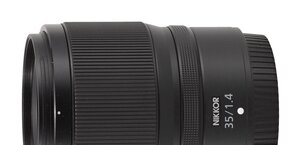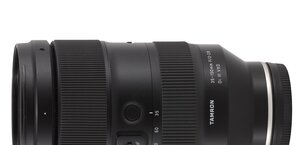Canon EF 8-15 mm f/4 L Fisheye USM
3. Build quality
In the photo below the tested lens is positioned between the 8 mm Samyang fisheye and the Sigma 1.4/30
 |
Please Support UsIf you enjoy our reviews and articles, and you want us to continue our work please, support our website by donating through PayPal. The funds are going to be used for paying our editorial team, renting servers, and equipping our testing studio; only that way we will be able to continue providing you interesting content for free. |
- - - - - - - - - - - - - - - - - - - - - - - - - - - - - - - - - - - - - - - - - - - - - - - -
The Canon EF 8–15 mm f/4.0L Fisheye USM is a lens belonging to the L series (Luxury) instruments - the top-of-the-range Canon series, produced completely in Japan and resistant to difficult weather conditions (dust, humidity). The casing of the lens is made of magnesium composites with a metal mount. The mount includes a rear lens, 21 mm in diameter, which is positioned on the same level at 8 mm focal length and hides by about 2 cm inside the casing when we pass to 15 mm focal length.
 |
On the casing itself we see a narrow, immobile ring on which you can find the C and H letters, mentioned previously. Immediately behind it there is a zoom ring. It is 16 mm wide, ribbed and featuring focal length markings. The ring moves smoothly and is well-damped in all the range. Its position near the mount can be problematic when you want to attach the lens to bodies of a lower class than 1D so these with in-build flash. Its protruding part, looking from above, simply obscures focal length markings. It is perhaps not exactly a big nuisance, because we use the ring while looking into the viewfinder, but such a problem was easily avoidable – it would be enough, for example, to switch the position of ribbed part and focal lengths markings.
 |
The next part of the lens features a distance scale under a window, expressed in feet and meters. On the left side of the scale we get a focus mode switch (AF/MF) and on the right – a LIMIT switch, which restricts the zoom to the range of 10-15 mm.
The next element is a manual focus ring. It is 16 mm wide, with a red stripe, so characteristic for L-series instruments; its ribs are rubber-padded. The ring’s work is smooth and really beyond reproach. Running through the whole scale takes a turn through 90 degrees. The front element is 7 cm in diameter and changes its position slightly. It is hidden the deepest at about 11 mm and it extends by several millimeters when you pass to extreme focal lengths.
The front element system is surrounded by a mount which enables you to attach a hood. The problem is that you can use it only on a body with an APS-C sensor. On full frame and at the shortest focal lengths the hood covers the field of view’s edges in the 8-12 mm focal range. At 13 mm, however, its influence is very slight and at 14 mm it becomes imperceptible. The hood is also used for attaching a quite big front cap.
| 8 mm | 10 mm |

|

|
| 12 mm | 14 mm |

|

|
When it comes to the optical construction we deal here with 14 elements which are positioned in 11 groups. The producer boasts of one aspherical element and one element made of low-dispersion UD glass. Inside you can also find an aperture with seven diaphragm blades which can be closed down to f/22. The producer emphasizes the fact that special SuperSpectra coating and SubWavelength Structure Coating (SWC) were used to ensure the lens’s good work against bright light. Additionally, the front and rear element are covered by special layers which make the lens easier to clean.

The buyer gets two caps, a petal-type lens hood and a soft pouch included in the box.
 |






